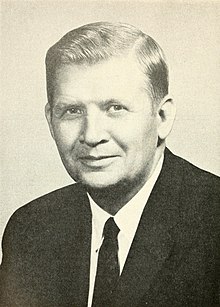Terry Sanford | |
|---|---|
 Sanford's portrait as Governor | |
| United States Senator from North Carolina | |
| In office December 10, 1986 – January 3, 1993 | |
| Preceded by | Jim Broyhill |
| Succeeded by | Lauch Faircloth |
| 6th President of Duke University | |
| In office April 2, 1970 – July 4, 1985 | |
| Preceded by | Douglas Knight |
| Succeeded by | H. Keith H. Brodie |
| 65th Governor of North Carolina | |
| In office January 5, 1961 – January 8, 1965 | |
| Lieutenant | Harvey Cloyd Philpott |
| Preceded by | Luther H. Hodges |
| Succeeded by | Dan K. Moore |
| Member of the North Carolina Senate from the 10th district | |
| In office January 7, 1953 – January 1955 Serving with James Bridger | |
| Preceded by | Bunn Frink Junius Powell |
| Succeeded by | Ray Walton Arthur Williamson |
| Personal details | |
| Born | James Terry Sanford August 20, 1917 Laurinburg, North Carolina, U.S. |
| Died | April 18, 1998 (aged 80) Durham, North Carolina, U.S. |
| Resting place | Duke Chapel |
| Political party | Democratic |
| Spouse | |
| Children | 2 |
| Education | University of North Carolina, Chapel Hill (AB, LLB) |
| Signature | |
| Military service | |
| Allegiance | United States |
| Branch/service | United States Army |
| Years of service | 1942–1945 1948–1960 |
| Rank | First Lieutenant |
| Unit | 517th Parachute Infantry Regiment North Carolina Army National Guard |
| Battles/wars | |
| Awards | Purple Heart Bronze Star |
James Terry Sanford (August 20, 1917 – April 18, 1998) was an American lawyer and politician from North Carolina. A member of the Democratic Party, Sanford served as the 65th Governor of North Carolina from 1961 to 1965, was a two-time U.S. presidential candidate in the 1970s, and served as a U.S. senator from 1986 to 1993. He was a strong proponent of public education and introduced several reforms and new programs in North Carolina's schools and institutions of higher education as the state's governor. From 1970 to 1985, Sanford served as the president of Duke University.
Born in Laurinburg, North Carolina, Sanford became a Federal Bureau of Investigation special agent after graduating from the University of North Carolina at Chapel Hill in 1939. During World War II he joined the United States Army and saw combat in the European Theater. Following the war, Sanford attended and graduated from the University of North Carolina School of Law and began a legal career in the late 1940s, soon becoming involved in politics. He served one term in the North Carolina Senate and managed W. Kerr Scott's U.S. Senate campaign in 1954 before running for governor in 1960. Focusing on improving education and economic opportunity, he defeated segregationist I. Beverly Lake, Sr. in the Democratic primary and was subsequently elected governor in the general election. Taking office in 1961, he pushed a controversial tax increase through the state legislature to double public spending on schools and created a commission to study further education. Growing increasingly anxious about opportunities for black students, he became the first Southern governor to call for an end to racially discriminatory employment practices in 1963 and used law enforcement to protect civil rights demonstrators. He also created the North Carolina Fund to alleviate poverty and lobbied for a major environmental research facility to be located at the Research Triangle Park.
Leaving the governorship in 1965, Sanford remained active in Democratic Party politics and engaged in the practice of law before being hired as President of Duke University in 1970. While there, he increased the school's fundraising, managed student protests, and created new institutions to study public policy issues. Retiring in 1985, he successfully ran for a U.S. Senate seat the following year. In Congress he maintained a liberal voting record, cofounding the International Commission for Central American Recovery and Development, objecting to the passage of a Flag Desecration Amendment, and criticizing American involvement in the Gulf War. Defeated in a bid for re-election in 1992, he spent his later years practicing law, writing, and teaching at Duke before he died of cancer in 1998. He is remembered in North Carolina as the "education governor" and served as a role model for several other Southern governors.